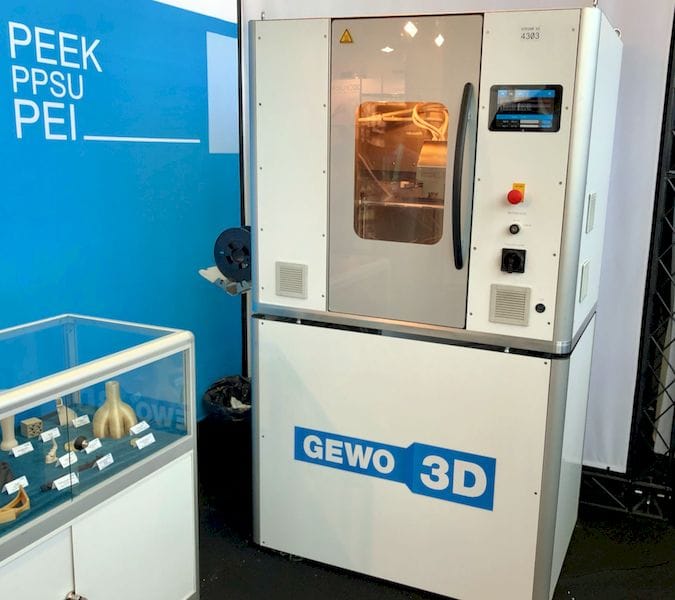![The high-temperature HTP 260 from GEWO 3D [Source: Fabbaloo]](https://fabbaloo.com/wp-content/uploads/2020/05/image-asset_img_5eb0a0458ab57.jpg)
If you’re seeking a very high-temperature 3D printer, you might want to look at the GEWO 3D HTP 260.
The Munich-based company was founded over 35 years ago as GEWO-Feinmechanik, and has specialized in producing complex manufacturing equipment for multiple industries, and now employing around 350 staff. Recently they locked their eyes on the world of 3D printing and have produced a high-temperature 3D printer that leverages all their prior knowledge of producing manufacturing equipment.
The HTP 260 is a very interesting professional 3D printer, as it is robustly designed for high-temperature material use.
The machine, which has a modest build volume of 350 x 150 x 165 mm, is able to withstand staggeringly hot temperatures. There is a double-wall design to encapsulate the heat. The print bed can be heated to a blistering 270C, perhaps the hottest print surface we’ve yet encountered.
But the key feature is that the build chamber itself can be heated up to 260C, hence the name of the machine: HTP 260. It’s so hot that the build chamber door has a magnetically operated closure system that is controlled with a safety switch. You don’t want to accidentally open this machine while it’s printing.
This tremendous heat makes it relatively simple to 3D print many high-temperature materials. GWO 3D has certified their own set of materials, which includes PEEK, PPSU, PSU, PEI and PEI-PC.
![The operation panel on the GEWO 3D HTP 260 [Source: Fabbaloo]](https://fabbaloo.com/wp-content/uploads/2020/05/image-asset_img_5eb0a045f232f.jpg)
The HTP 260 has a number of other now-standard features you would expect on a machine of this type, including a large touchscreen for control, which is powered by a hefty PC under the covers running Linux and Octoprint. It’s fully calibrated automatically, and has all the usual networking connections.
The HTP 260 is a significant machine to install. It weighs 200kg, requires 16A power and a minimum of 6.5bar air pressure to operate.
GEWO 3D is also working on a mysterious prototype for a new machine, shown here. This machine is said to include features that will dramatically speed up printing, making the machine more suitable for production environments.
![Fabbaloo’s Sarah Goehrke checks out the mysterious GEWO 3D “zebra” prototype [Source: Fabbaloo]](https://fabbaloo.com/wp-content/uploads/2020/05/image-asset_img_5eb0a046453cc.jpg)
One of the new features to be included in this machine is an automatic nozzle changer, which will pick up the right nozzle for the job all by itself.
You might be wondering about this strange pattern on this machine. We asked about it and were told that it was “because it is a prototype”.
This still didn’t register until someone pointed out that BMW, another Munich-based company, often paints their new vehicles in weird zebra-like patterns similar to this.
BMW does this to frustrate photographers attempting to capture their new automobile models on test tracks. The pattern obscures the vehicle’s contour lines, making it difficult to understand what the vehicle will look like in its final form.
I’m not sure that the same equation applies to a 3D printer, but it certainly makes for an interesting appearance.
VIA GEWO 3D











MiniFactory’s new software produces a very useful report for each 3D print that may be important for clients. We had a close look at one.